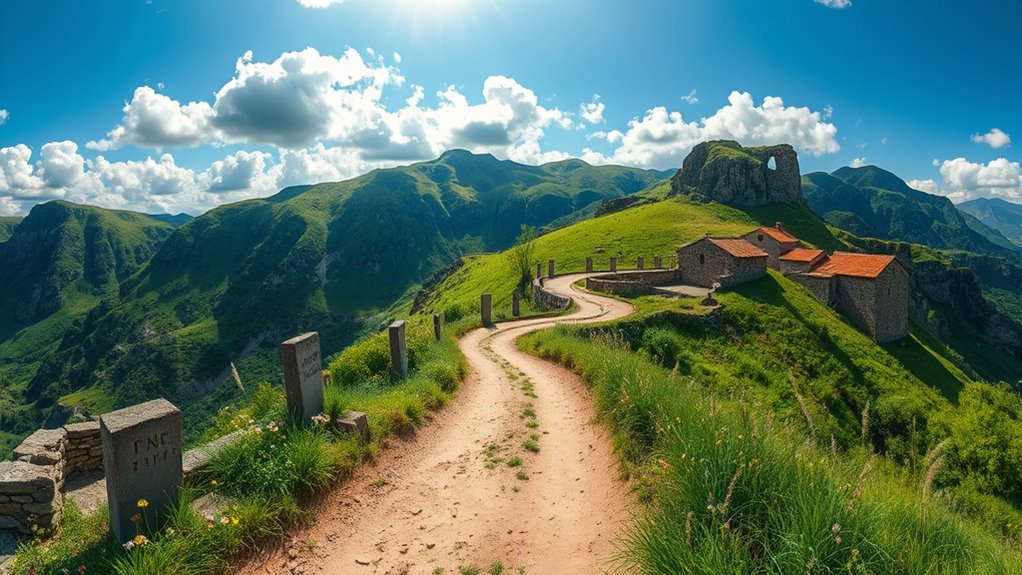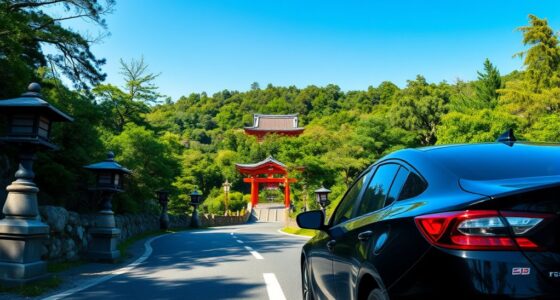Crossing the Balkans via Via Egnatia offers a journey through centuries of history, scenic landscapes, and vibrant traditions. As you travel the ancient route, you’ll encounter archaeological sites, Ottoman relics, and charming towns blending Byzantine and modern architecture. Natural sights like mountains, rivers, and meadows surround you, while modern infrastructure guarantees smooth border crossings. If you want to discover the region’s hidden gems and cultural richness, there’s plenty more to explore along this historic route.
Key Takeaways
- Via Egnatia connects Greece with the Balkans, offering a historic route for cultural exchange and modern travel.
- Modern infrastructure and border facilities streamline crossing procedures, reducing delays and enhancing security.
- The route features scenic landscapes, including mountains, rivers, and ancient sites, enriching the travel experience.
- Cross-border trade and regional connectivity are boosted through improved roads and customs procedures.
- Cultural heritage sites, festivals, and local traditions along Via Egnatia provide immersive cultural exploration.
Tracing the Origins of Via Egnatia

To understand the origins of Via Egnatia, you need to look back to the Roman Empire, which built the road in the 2nd century BCE to connect Rome with its eastern provinces. This route was essential for facilitating ancient trade, allowing goods, armies, and ideas to flow across the Balkans and into Asia Minor. Over centuries, the route evolved, influenced by various powers, including the Ottomans. Ottoman influences shaped much of the infrastructure and use of the road, integrating it into their empire’s administrative and military systems. The route’s strategic importance persisted through these changes, serving as a critical corridor for commerce and conquest. Additionally, modern infrastructure development has continued to enhance its connectivity and significance, supported by ongoing investments in transportation networks. Today, Via Egnatia’s origins reflect a blend of ancient trade networks and Ottoman legacy, highlighting its enduring significance.
Key Stops Along the Route
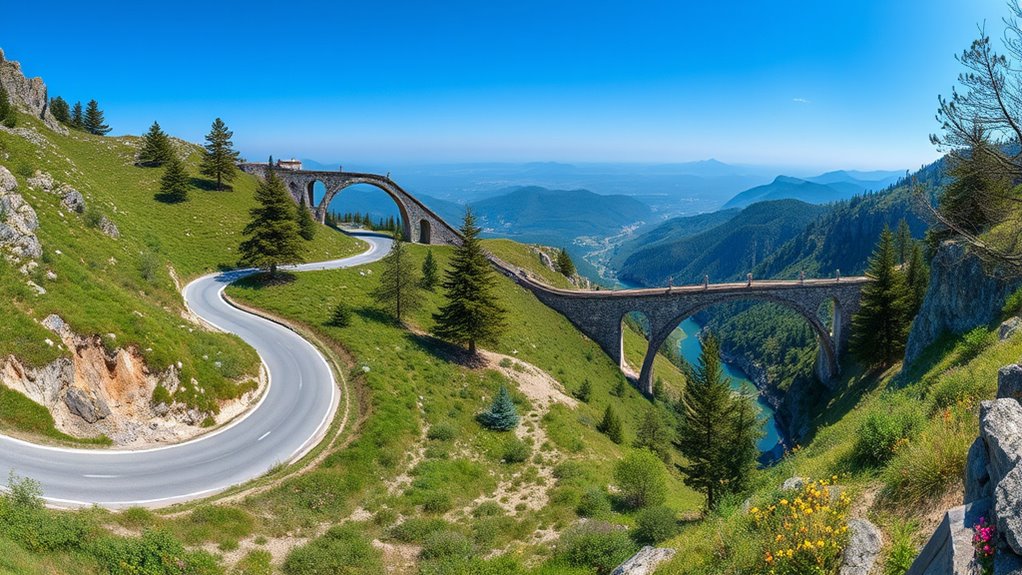
As you journey along Via Egnatia, you’ll encounter a series of historic and strategic stops that reveal its rich past. These key sites include:
- The medieval monasteries that once served as spiritual centers and cultural hubs.
- Ottoman relics, such as ancient mosques and fortresses, reflecting the region’s diverse history.
- Ancient ruins that highlight the route’s importance in trade and military strategy.
- Towns with preserved architecture showcasing the blend of Byzantine, Ottoman, and modern influences.
- Understanding the headphone options and connections available can enhance your experience, especially if you wish to listen to guided tours or audio guides during your exploration.
Each stop offers a glimpse into different eras, emphasizing the route’s role in shaping Balkan history. As you explore these sites, you’ll connect with the layers of civilization that have left their mark along Via Egnatia.
Cultural Heritage and Local Traditions
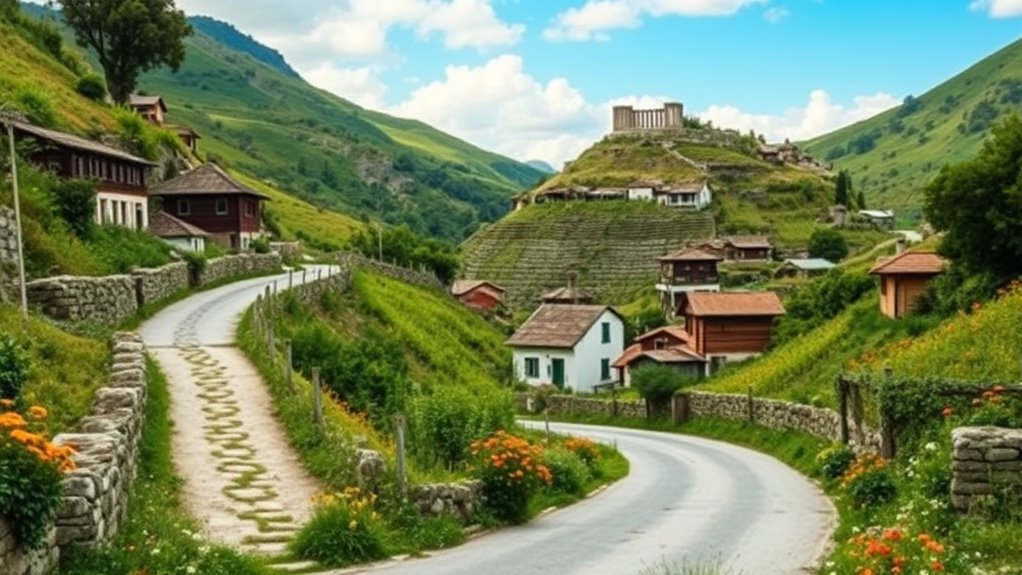
As you travel along Via Egnatia, you’ll notice how ancient customs still shape local life today. Regional art and music reflect centuries of tradition, offering a vibrant window into the area’s history. These cultural treasures invite you to experience the enduring spirit of the Balkans firsthand. Engaging with local traditions can deepen your appreciation for the region’s cultural heritage, which continues to thrive through community celebrations and artisanship. Additionally, the preservation of traditional crafts demonstrates how artisans keep these customs alive across generations. Furthermore, the authentic ambiance created by these practices enriches the travel experience and fosters a deeper connection to the region’s identity. Incorporating cultural preservation efforts helps sustain these vibrant traditions for future visitors.
Ancient Customs Preserved
Despite the passage of centuries, many ancient customs along the Via Egnatia still thrive, offering you a tangible link to the region’s rich history. You might witness lively medieval festivals that celebrate local legends and traditions, keeping history alive. Traditional crafts, like pottery and weaving, are preserved through skilled artisans who pass down their techniques. To immerse yourself further, look out for:
- Local markets showcasing handmade textiles and jewelry
- Folk dances performed during festivals
- Ancient rituals still practiced in villages
- Traditional culinary customs passed through generations
These customs connect you directly to the past, making your journey along the Via Egnatia a living experience of history, culture, and cultural heritage. Additionally, understanding the personality traits of locals can enrich your interactions and deepen your appreciation of the region’s unique cultural fabric. Recognizing the importance of sustainable practices in local communities also enhances your awareness of how traditions are maintained over time. Furthermore, ongoing efforts in digital preservation help safeguard these customs for future generations. Engaging with local communities can foster intercultural understanding, promoting respect and collaboration across diverse cultural backgrounds.
Regional Art & Music
The rich customs along the Via Egnatia extend beyond festivals and crafts to vibrant regional art and music that echo centuries of cultural tradition. As you travel, you’ll encounter lively displays of Balkan folk art, from intricate embroidery to colorful pottery rooted in local history. Music plays an essential role in community life, with traditional instruments and melodies that tell stories of past generations. Regional festivals celebrate these artistic expressions, blending dance, song, and craftsmanship into immersive experiences. You might find yourself captivated by lively performances at celebrations or admiring handmade textiles at local markets. This artistic heritage offers a window into the soul of the Balkans, connecting you to a region where music and art remain vital expressions of identity and community. Additionally, the use of performance brakes and other tuning modifications in local vehicles can reflect regional preferences and practical adaptations, adding to the cultural tapestry. Exploring eco-friendly travel options in the area can enhance your experience while supporting sustainable tourism practices. Recognizing the importance of regional art and music helps deepen your appreciation for the enduring cultural legacy along the historic route, especially as many of these traditions are preserved through local craftsmanship and community celebrations.
Navigating Modern Borders and Infrastructure
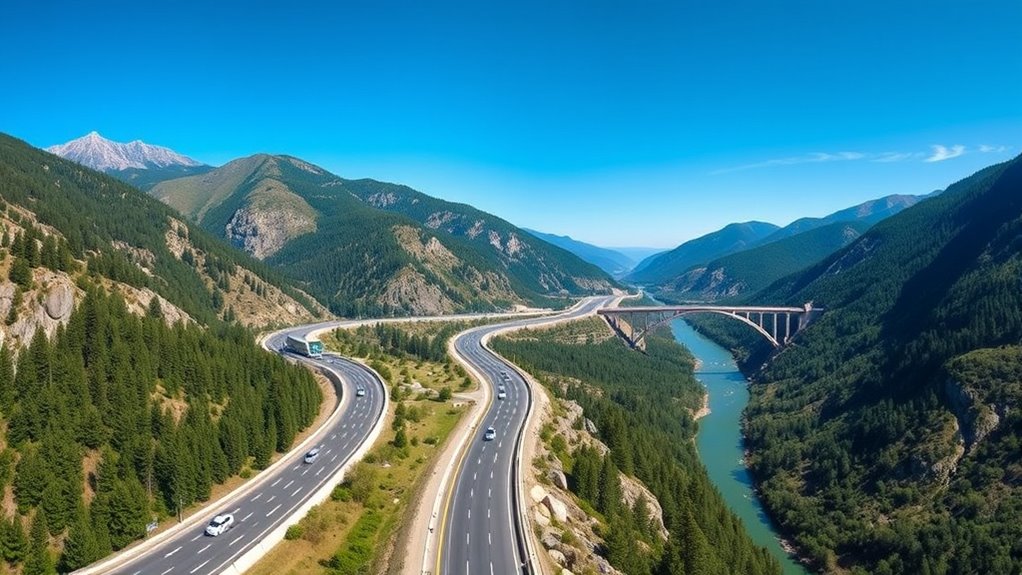
As you cross modern borders, you’ll encounter streamlined controls and updated infrastructure that make travel smoother. Improvements in roads and transportation hubs enhance connectivity between countries along the route. These developments considerably ease your journey through the Balkans today. Additionally, the integration of advanced automation technologies in transportation systems is expected to further improve efficiency and safety on these routes. Enhanced border management systems contribute to faster processing times and increased security, further facilitating seamless travel. The use of Cookies to optimize user experience and streamline services is increasingly being adopted in these modern facilities. Furthermore, implementing modern security protocols helps maintain safety standards while expediting border crossings. Incorporating modern infrastructure is also vital for supporting increased traffic and ensuring long-term sustainability of travel routes.
Modern Border Controls
Traveling modern borders along the Via Egnatia involves dealing with increasingly sophisticated infrastructure and regulations designed to guarantee security and streamline travel. You’ll encounter enhanced border security measures that use advanced technology to detect threats quickly. Customs procedures are now more efficient, often requiring digital declarations and automated systems. To navigate these effectively, keep these points in mind:
- Present your travel documents promptly at border crossings.
- Follow signage for customs declarations and security checks.
- Be prepared for potential health screenings or additional inquiries.
- Use designated lanes for quick processing if eligible.
- Awareness of security zone info can help you understand the importance of these measures. Understanding the advanced security measures can further assist in a smoother crossing experience.
These measures aim to make crossing smoother while maintaining security standards. Staying informed about current rules helps you avoid delays and ensures a seamless journey along the Via Egnatia.
Infrastructure Upgrades
Modern infrastructure upgrades along the Via Egnatia have markedly improved your experience at border crossings. Roads are smoother, signs clearer, and facilities more efficient, making travel seamless. These improvements support sustainable tourism by reducing environmental impact and encouraging responsible exploration. As you pass through regions rich in local culinary traditions, you’ll notice new rest stops and markets that showcase authentic flavors. This fosters a deeper connection to local culture while respecting the environment. The upgrades also include smart technology that streamlines border processes, saving you time and reducing stress.
| Emotion | Experience |
|---|---|
| Excitement | Discovering hidden culinary gems |
| Comfort | Traveling smoothly and efficiently |
| Pride | Supporting local traditions |
| Connection | Embracing regional beauty |
Cross-Border Connectivity
Moving through the borders along the Via Egnatia has become smoother thanks to streamlined customs procedures and integrated infrastructure. This improved cross-border connectivity boosts trade routes, making transportation faster and more efficient. As you travel, you’ll notice how modern infrastructure supports local economies and cultural exchanges. Here’s what you can expect:
- Faster customs clearance, reducing delays.
- Better road networks connecting key border crossings.
- Increased movement of goods, including regional specialties.
- Opportunities to explore culinary traditions influenced by cross-border interactions.
These developments not only facilitate trade but also deepen cultural ties, allowing you to experience the diverse culinary traditions that define the Balkans. Enhanced connectivity keeps the region vibrant, promoting cooperation and shared heritage along the historic Via Egnatia.
Scenic Landscapes and Natural Wonders
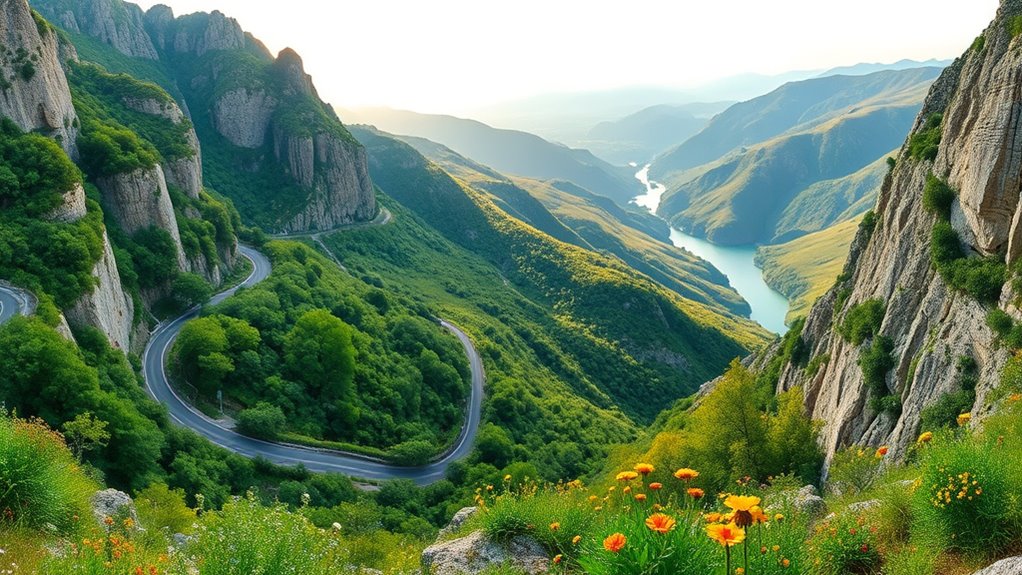
As you journey along the Via Egnatia, you’re treated to a stunning tapestry of landscapes that showcase the region’s natural beauty. You’ll pass through vibrant wildflower meadows, bursting with colors during spring and summer, inviting you to pause and take in the fragrant blooms. Towering mountain vistas dominate the horizon, offering breathtaking views that inspire awe. The route winds through lush valleys and rugged hills, revealing stunning natural wonders at every turn. You might catch sight of crystal-clear rivers carving through the terrain or ancient trees standing as silent witnesses to history. These landscapes create an immersive experience, connecting you deeply with the region’s rich natural heritage. Each vista highlights the Balkans’ diverse and enthralling scenery, making your journey truly memorable.
Tips for a Memorable Journey
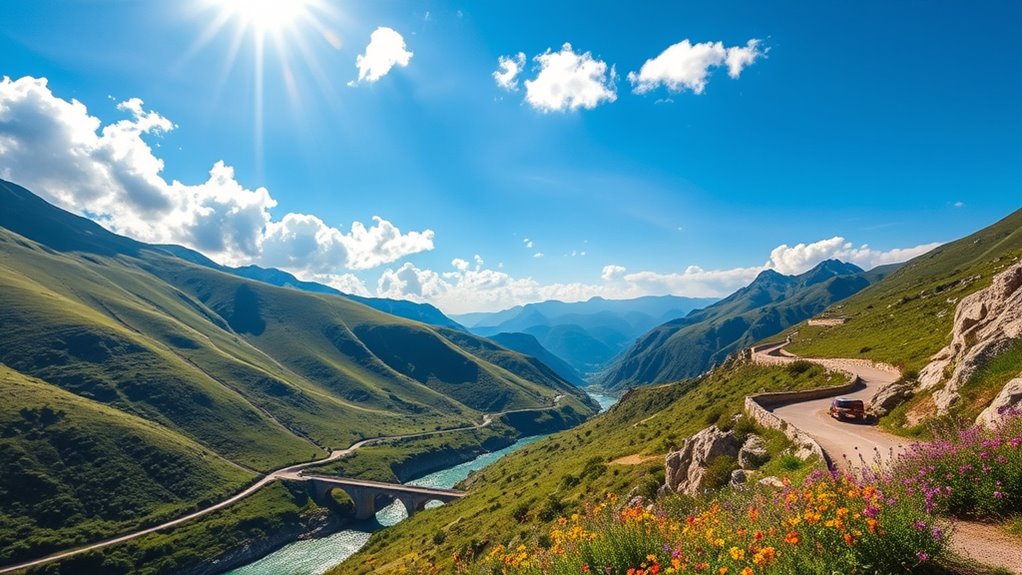
To make your journey along the Via Egnatia truly unforgettable, start by planning your itinerary carefully. Consider tailoring your route to include local cuisine and traditional festivals, which add authentic flavor to your trip. Here are some tips:
- Sample regional dishes at local tavernas to experience authentic flavors.
- Attend traditional festivals to immerse yourself in local culture and customs.
- Stay flexible to explore spontaneous detours and hidden spots.
- Engage with locals to gain insights and stories that enrich your journey.
Exploring the Hidden Gems of the Balkans
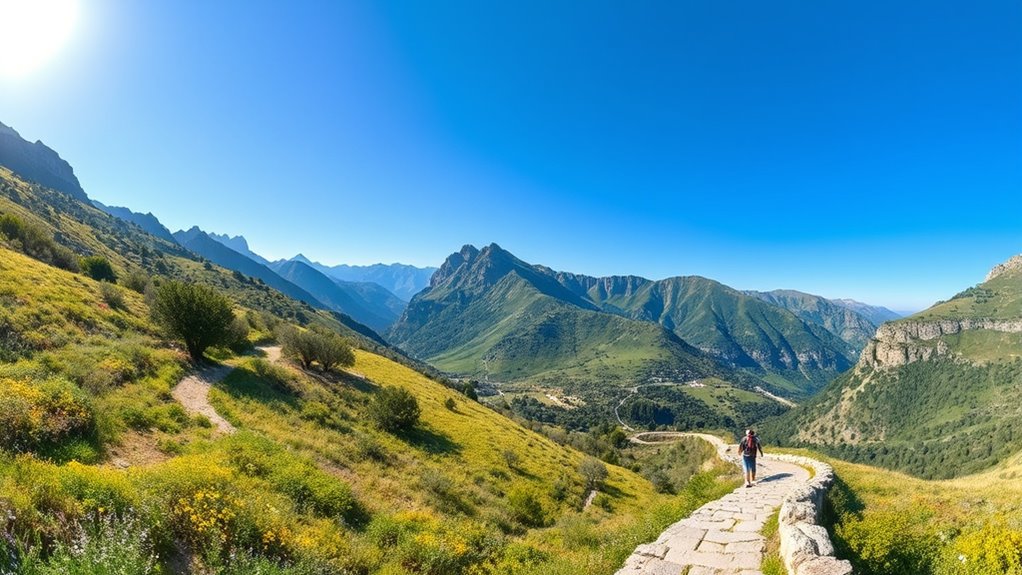
Ever wondered where the Balkans’ most enthralling secrets lie? It’s in its hidden gems, waiting for you to uncover. Venture off the beaten path to discover charming villages where local cuisine is authentic and delicious. Savor dishes made with age-old recipes that tell stories of tradition and culture. Don’t miss traditional festivals, which burst with vibrant music, dance, and customs. These celebrations offer a unique glimpse into local life and heritage. Exploring lesser-known spots like secluded monasteries, ancient ruins, or scenic valleys adds depth to your journey. Each hidden corner reveals a new layer of the Balkans’ rich history and lively culture. So, keep your curiosity alive and embrace the surprises that make this region truly unforgettable.
Frequently Asked Questions
What Are the Best Times of Year to Travel via Egnatia?
You should travel during the spring and fall when the seasonal weather is mild and pleasant, making your journey more enjoyable. Avoid peak travel seasons like summer, when roads can be crowded and the heat is intense. Spring and autumn typically offer better conditions, fewer tourists, and more comfortable temperatures, ensuring a smoother experience as you explore the scenic route. Planning your trip during these times enhances your journey across the Balkans.
Are There Guided Tours Available Along the Route?
Like a seasoned explorer, you can find guided tour options along the route. Many travel agency services offer organized trips, providing insightful guides and hassle-free planning. These tours give you a deeper understanding of the region’s history and culture while making your journey more comfortable. Check with local operators or online platforms to discover the best guided tours available, ensuring an enriching experience along your crossing.
How Safe Is It to Travel Through the Balkans via This Route?
Traveling through the Balkans generally feels safe, but you should consider security concerns and road conditions. Stay updated on local advice, avoid risky areas, and plan your route carefully. Some roads might be rough or poorly maintained, so drive cautiously. By staying alert and informed, you can enjoy your journey while minimizing risks. Always check recent travel advisories to guarantee a smooth and secure trip through the region.
What Local Cuisines Can Travelers Expect Along via Egnatia?
Did you know the Balkans boast over 200 traditional dishes? As you travel along Via Egnatia, you’ll taste regional culinary specialties like Greece’s moussaka, Albania’s tave kosi, and North Macedonia’s tavče gravče. Expect vibrant flavors, fresh ingredients, and hearty meals. Each country offers unique tastes rooted in history, giving you an authentic experience of traditional Balkan dishes that reflect the rich cultural tapestry of the region.
Are There Accommodations Suitable for Backpackers Along the Route?
You’ll find budget hostels and simple guesthouses suitable for backpackers along the route, making it easy to stay on a budget. Backpacker tips include booking in advance when possible and looking for accommodations with communal spaces for socializing. Keep an eye out for small family-run hostels or guesthouses, which often offer authentic experiences and friendly atmospheres, helping you save money and enjoy your journey along the Via Egnatia.
Conclusion
Your journey along Via Egnatia isn’t just a trip through the Balkans; it’s a bridge connecting past and present, tradition and transformation. Each step you take symbolizes resilience and unity, reminding you that borders are temporary, but shared history and culture endure. As you cross these lands, let the road be your thread, weaving a tapestry of discovery and connection that lasts beyond the journey itself. The Balkans await, ready to reveal their timeless stories.
